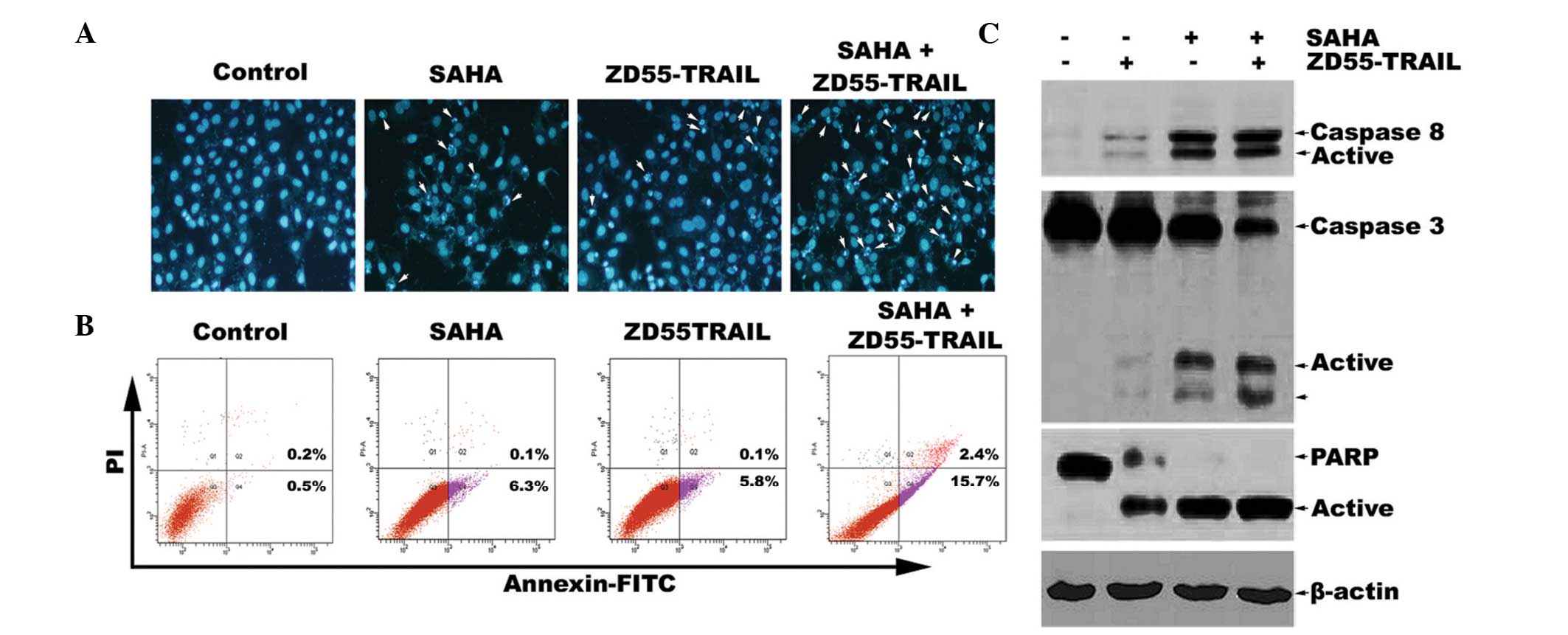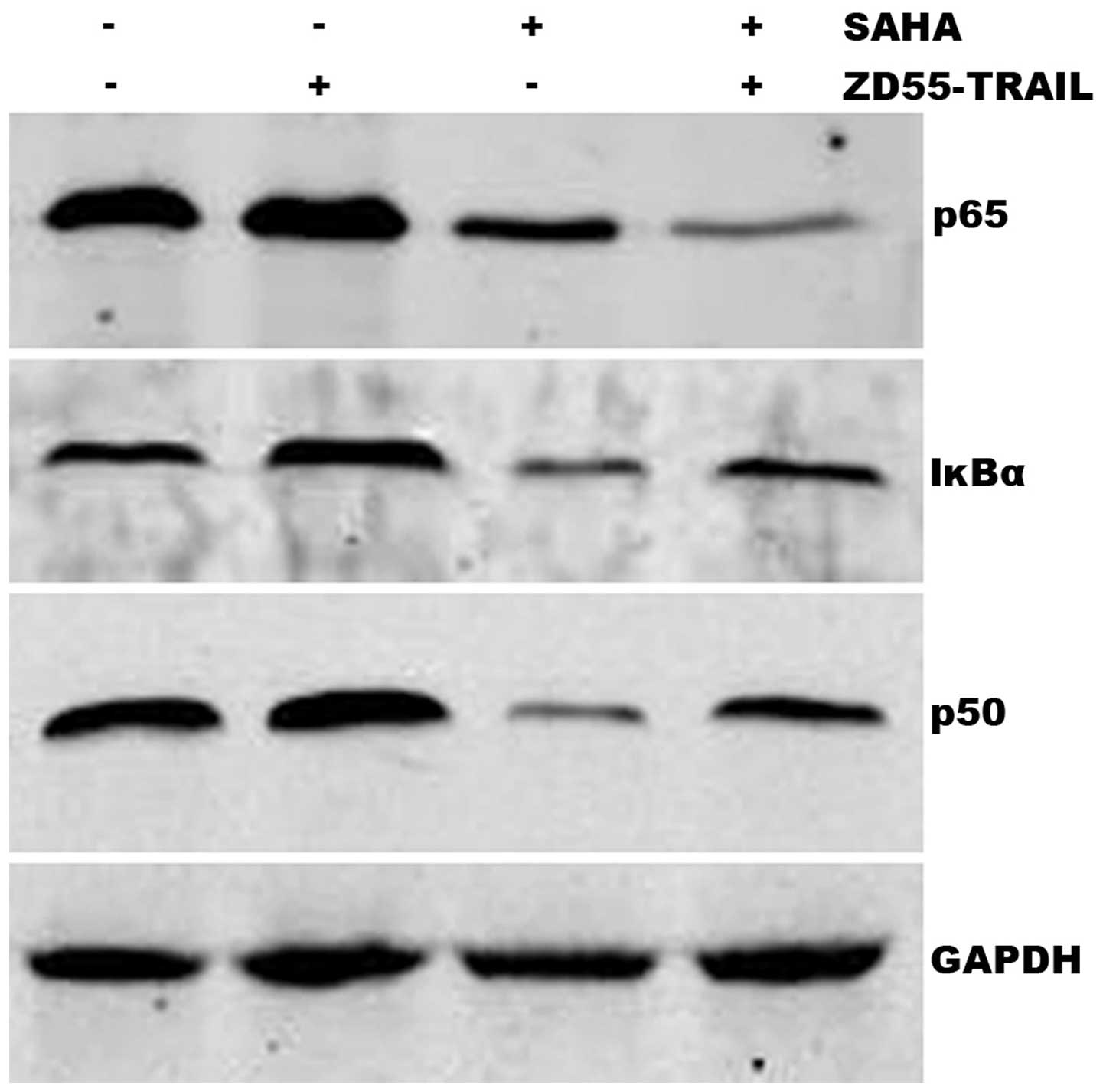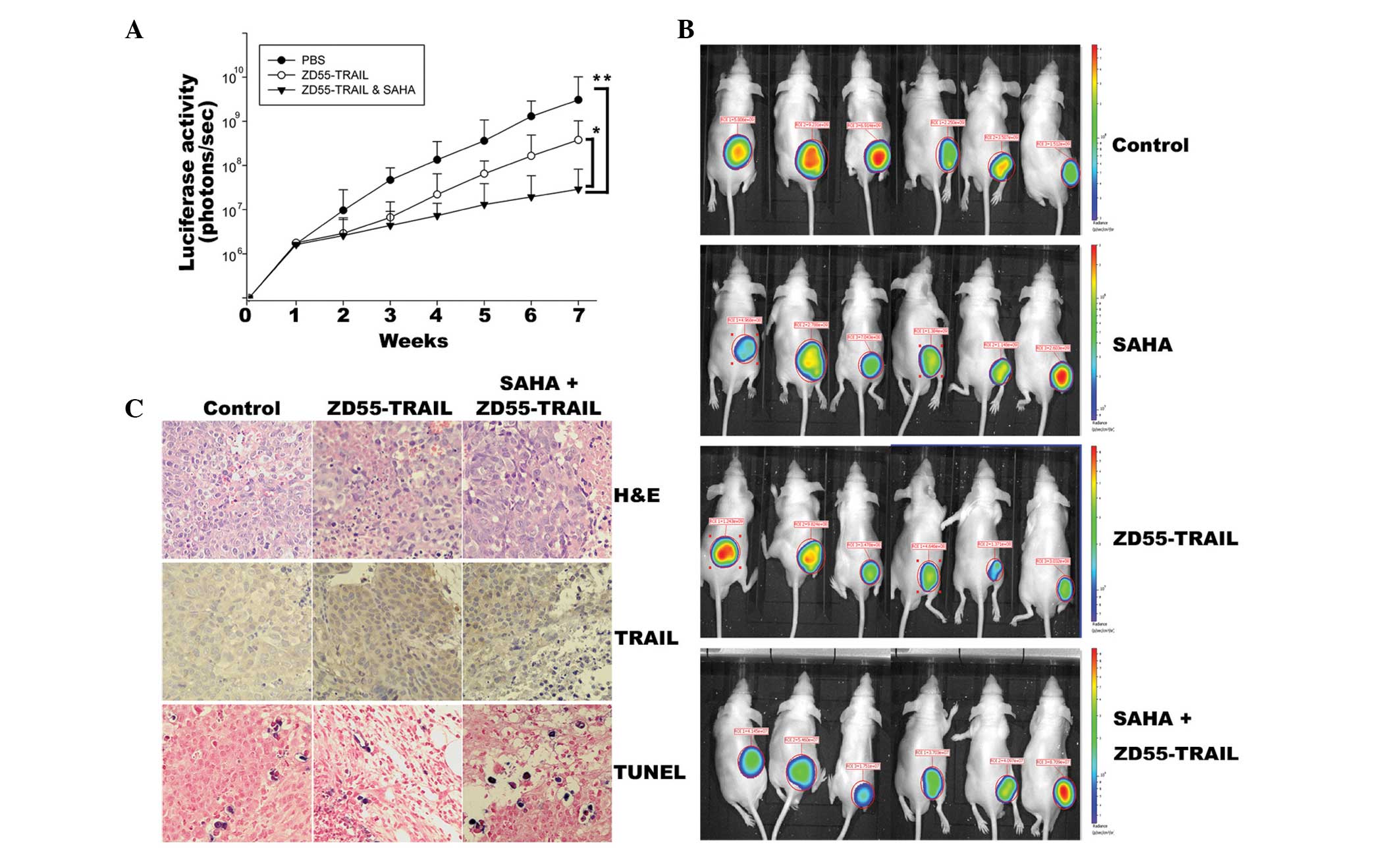|
1
|
Jemal A, Siegel R, Ward E, Murray T, Xu J
and Thun MJ: Cancer statistics, 2007. CA Cancer J Clin. 57:43–66.
2007. View Article : Google Scholar : PubMed/NCBI
|
|
2
|
Rose PG, Bundy BN, Watkins EB, et al:
Concurrent cisplatin-based radiotherapy and chemotherapy for
locally advanced cervical cancer. N Engl J Med. 340:1144–1153.
1999. View Article : Google Scholar : PubMed/NCBI
|
|
3
|
Mountzios G, Soultati A, Pectasides D,
Pectasides E, Dimopoulos MA and Papadimitriou CA: Developments in
the systemic treatment of metastatic cervical cancer. Cancer Treat
Rev. 39:430–443. 2013. View Article : Google Scholar
|
|
4
|
Hermiston TW and Kuhn I: Armed therapeutic
viruses: strategies and challenges to arming oncolytic viruses with
therapeutic genes. Cancer Gene Ther. 9:1022–1035. 2002. View Article : Google Scholar
|
|
5
|
Zhang ZL, Zou WG, Luo CX, et al: An armed
oncolytic adenovirus system, ZD55-gene, demonstrating potent
antitumoral efficacy. Cell Res. 13:481–489. 2003. View Article : Google Scholar
|
|
6
|
Dong F, Wang L, Davis JJ, et al:
Eliminating established tumor in nu/nu nude mice by a tumor
necrosis factor-α-related apoptosis inducing ligand-armed oncolytic
adenovirus. Clin Cancer Res. 12:5224–5230. 2006. View Article : Google Scholar : PubMed/NCBI
|
|
7
|
Li J, Bonifati S, Hristov G, et al:
Synergistic combination of valproic acid and oncolytic parvovirus
H-1PV as a potential therapy against cervical and pancreatic
carcinomas. EMBO Mol Med. 5:1537–1555. 2013. View Article : Google Scholar : PubMed/NCBI
|
|
8
|
Pei Z, Chu L, Zou W, et al: An oncolytic
adenoviral vector of Smac increases antitumor activity of TRAIL
against HCC in human cells and in mice. Hepatology. 39:1371–1381.
2004. View Article : Google Scholar : PubMed/NCBI
|
|
9
|
Zhang Y, Gu J, Zhao L, et al: Complete
elimination of colorectal tumor xenograft by combined manganese
superoxide dismutase with tumor necrosis factor-related
apoptosis-inducing ligand gene virotherapy. Cancer Res.
66:4291–4298. 2006. View Article : Google Scholar : PubMed/NCBI
|
|
10
|
Wang SB, Tan Y, Lei W, et al: Complete
eradication of xenograft hepatoma by oncolytic adenovirus ZD55
harboring TRAIL-IETD-Smac gene with broad antitumor effect. Hum
Gene Ther. 23:992–1002. 2012. View Article : Google Scholar : PubMed/NCBI
|
|
11
|
Tan J, Cang S, Ma Y, Petrillo RL and Liu
D: Novel histone deacetylase inhibitors in clinical trials as
anti-cancer agents. J Hematol Oncol. 3:52010. View Article : Google Scholar : PubMed/NCBI
|
|
12
|
Bots M and Johnstone RW: Rational
combinations using HDAC inhibitors. Clin Cancer Res. 15:3970–3977.
2009. View Article : Google Scholar : PubMed/NCBI
|
|
13
|
Hadnagy A, Beaulieu R and Balicki D:
Histone tail modifications and noncanonical functions of histones:
perspectives in cancer epigenetics. Mol Cancer Ther. 7:740–748.
2008. View Article : Google Scholar : PubMed/NCBI
|
|
14
|
Han BR, You BR and Park WH: Valproic acid
inhibits the growth of HeLa cervical cancer cells via
caspase-dependent apoptosis. Oncol Rep. 30:2999–3005.
2013.PubMed/NCBI
|
|
15
|
Takai N, Kira N, Ishii T, Nishida M, Nasu
K and Narahara H: Novel chemotherapy using histone deacetylase
inhibitors in cervical cancer. Asian Pac J Cancer Prev. 12:575–580.
2011.PubMed/NCBI
|
|
16
|
Feng D, Wu J, Tian Y, et al: Targeting of
histone deacetylases to reactivate tumour suppressor genes and its
therapeutic potential in a human cervical cancer xenograft model.
PLoS One. 8:e806572013. View Article : Google Scholar : PubMed/NCBI
|
|
17
|
Chaudhari BR, Murphy RF and Agrawal DK:
Following the TRAIL to apoptosis. Immunol Res. 35:249–262. 2006.
View Article : Google Scholar : PubMed/NCBI
|
|
18
|
Thaci B, Ulasov IV, Wainwright DA and
Lesniak MS: The challenge for gene therapy: innate immune response
to adenoviruses. Oncotarget. 2:113–121. 2011.PubMed/NCBI
|
|
19
|
Tamanini A, Nicolis E, Bonizzato A,
Bezzerri V, Melotti P, Assael BM and Cabrini G: Interaction of
adenovirus type 5 fiber with the coxsackievirus and adenovirus
receptor activates inflammatory response in human respiratory
cells. J Virol. 80:11241–11254. 2006. View Article : Google Scholar : PubMed/NCBI
|
|
20
|
Verdino P, Witherden DA, Havran WL and
Wilson IA: The molecular interaction of CAR and JAML recruits the
central cell signal transducer PI3K. Science. 329:1210–1214. 2010.
View Article : Google Scholar : PubMed/NCBI
|
|
21
|
Tong Y, Zhu W, Huang X, You L, Han X, Yang
C and Qian W: PI3K inhibitor LY294002 inhibits activation of the
Akt/mTOR pathway induced by an oncolytic adenovirus expressing
TRAIL and sensitizes multiple myeloma cells to the oncolytic virus.
Oncol Rep. 31:1581–1588. 2014.PubMed/NCBI
|
|
22
|
Kaiser J: Combining targeted drugs to stop
resistant tumors. Science. 331:1542–1545. 2011. View Article : Google Scholar : PubMed/NCBI
|
|
23
|
Alonso MM, Gomez-Manzano C, Jiang H, et
al: Combination of the oncolytic adenovirus ICOVIR-5 with
chemotherapy provides enhanced anti-glioma effect in vivo. Cancer
Gene Ther. 14:756–761. 2007. View Article : Google Scholar : PubMed/NCBI
|
|
24
|
Young BA, Spencer JF, Ying B, Tollefson
AE, Toth K and Wold WS: The role of cyclophosphamide in enhancing
antitumor efficacy of an adenovirus oncolytic vector in
subcutaneous Syrian hamster tumors. Cancer Gene Ther. 20:521–530.
2013. View Article : Google Scholar : PubMed/NCBI
|
|
25
|
Meng HT, Li L, Liu H, Wang Y, Li GC and
Qian WB: Homoharringtonine acts synergistically with SG235-TRAIL, a
conditionally replicating adenovirus, in human leukemia cell lines.
Acta Pharmacol Sin. 30:1529–1536. 2009. View Article : Google Scholar : PubMed/NCBI
|
|
26
|
Galanis E, Okuno SH, Nascimento AG, et al:
Phase I-II trial of ONYX-015 in combination with MAP chemotherapy
in patients with advanced sarcomas. Gene Ther. 12:437–445. 2005.
View Article : Google Scholar : PubMed/NCBI
|
|
27
|
Opyrchal M, Aderca I and Galanis E: Phase
I clinical trial of locoregional administration of the oncolytic
adenovirus ONYX-015 in combination with mitomycin-C, doxorubicin
and cisplatin chemotherapy in patients with advanced sarcomas.
Methods Mol Biol. 542:705–717. 2009.
|
|
28
|
Jiang Y, Wang Y, Su Z, Yang L, Guo W, Liu
W and Zuo J: Synergistic induction of apoptosis in HeLa cells by
the proteasome inhibitor bortezomib and histone deacetylase
inhibitor SAHA. Mol Med Rep. 3:613–619. 2010.
|
|
29
|
Tambunan US, Bakri R, Prasetia T,
Parikesit AA and Kerami D: Molecular dynamics simulation of complex
Histones Deacetylase (HDAC) Class II Homo Sapiens with
suberoylanilide hydroxamic acid (SAHA) and its derivatives as
inhibitors of cervical cancer. Bioinformation. 9:696–700. 2013.
View Article : Google Scholar : PubMed/NCBI
|
|
30
|
Kelly WK, O’Connor OA, Krug LM, et al:
Phase I study of an oral histone deacetylase inhibitor,
suberoylanilide hydroxamic acid, in patients with advanced cancer.
J Clin Oncol. 23:3923–3931. 2005. View Article : Google Scholar : PubMed/NCBI
|
|
31
|
Hellwig CT and Rehm M: TRAIL signaling and
synergy mechanisms used in TRAIL-based combination therapies. Mol
Cancer Ther. 11:3–13. 2012. View Article : Google Scholar : PubMed/NCBI
|
|
32
|
Thanaketpaisarn O, Waiwut P, Sakurai H and
Saiki I: Artesunate enhances TRAIL-induced apoptosis in human
cervical carcinoma cells through inhibition of the NF-κB and
PI3K/Akt signaling pathways. Int J Oncol. 39:279–285.
2011.PubMed/NCBI
|
|
33
|
Williams AC, Smartt H, H-Zadeh AM,
Macfarlane M, Paraskeva C and Collard TJ: Insulin-like growth
factor binding protein 3 (IGFBP-3) potentiates TRAIL-induced
apoptosis of human colorectal carcinoma cells through inhibition of
NF-kappaB. Cell Death Differ. 14:137–145. 2007. View Article : Google Scholar
|
|
34
|
Ricci MS, Kim SH, Ogi K, et al: Reduction
of TRAIL-induced Mcl-1 and cIAP2 by c-Myc or sorafenib sensitizes
resistant human cancer cells to TRAIL-induced death. Cancer Cell.
12:66–80. 2007. View Article : Google Scholar : PubMed/NCBI
|
|
35
|
Fandy TE, Shankar S, Ross DD, Sausville E
and Srivastava RK: Interactive effects of HDAC inhibitors and TRAIL
on apoptosis are associated with changes in mitochondrial functions
and expressions of cell cycle regulatory genes in multiple myeloma.
Neoplasia. 7:646–657. 2005. View Article : Google Scholar : PubMed/NCBI
|
|
36
|
Lauricella M, Ciraolo A, Carlisi D, Vento
R and Tesoriere G: SAHA/TRAIL combination induces detachment and
anoikis of MDA-MB231 and MCF-7 breast cancer cells. Biochimie.
94:287–299. 2012. View Article : Google Scholar
|
|
37
|
Cao H, Cheng Y, You L, Qian J and Qian W:
Homoharringtonine and SAHA synergistically enhance apoptosis in
human acute myeloid leukemia cells through upregulation of TRAIL
and death receptors. Mol Med Rep. 7:1838–1844. 2013.PubMed/NCBI
|
|
38
|
Al-Yacoub N, Fecker LF, Möbs M, Plötz M,
Braun FK, Sterry W and Eberle J: Apoptosis induction by SAHA in
cutaneous T-cell lymphoma cells is related to downregulation of
c-FLIP and enhanced TRAIL signaling. J Invest Dermatol.
132:2263–2274. 2012. View Article : Google Scholar : PubMed/NCBI
|
|
39
|
Chen S, Zhao Y, Gou WF, Zhao S, Takano Y
and Zheng HC: The anti-tumor effects and molecular mechanisms of
suberoylanilide hydroxamic acid (SAHA) on the aggressive phenotypes
of ovarian carcinoma cells. PLoS One. 8:e797812013. View Article : Google Scholar : PubMed/NCBI
|
|
40
|
Kanerva A, Lavilla-Alonso S, Raki M, et
al: Systemic therapy for cervical cancer with potentially
regulatable oncolytic adenoviruses. PLoS One. 3:e29172008.
View Article : Google Scholar : PubMed/NCBI
|
|
41
|
Wang W, Sima N, Kong D, et al: Selective
targeting of HPV-16 E6/E7 in cervical cancer cells with a potent
oncolytic adenovirus and its enhanced effect with radiotherapy in
vitro and vivo. Cancer Lett. 291:67–75. 2010. View Article : Google Scholar
|
|
42
|
Wang H, Song X, Zhang H, et al:
Potentiation of tumor radiotherapy by a radiation-inducible
oncolytic and oncoapoptotic adenovirus in cervical cancer
xenografts. Int J Cancer. 130:443–453. 2012. View Article : Google Scholar
|














